The best roast chicken recipe is a simple one! You only need two ingredients to roast a whole chicken that is crispy on the outside and juicy on the inside—chicken and salt.
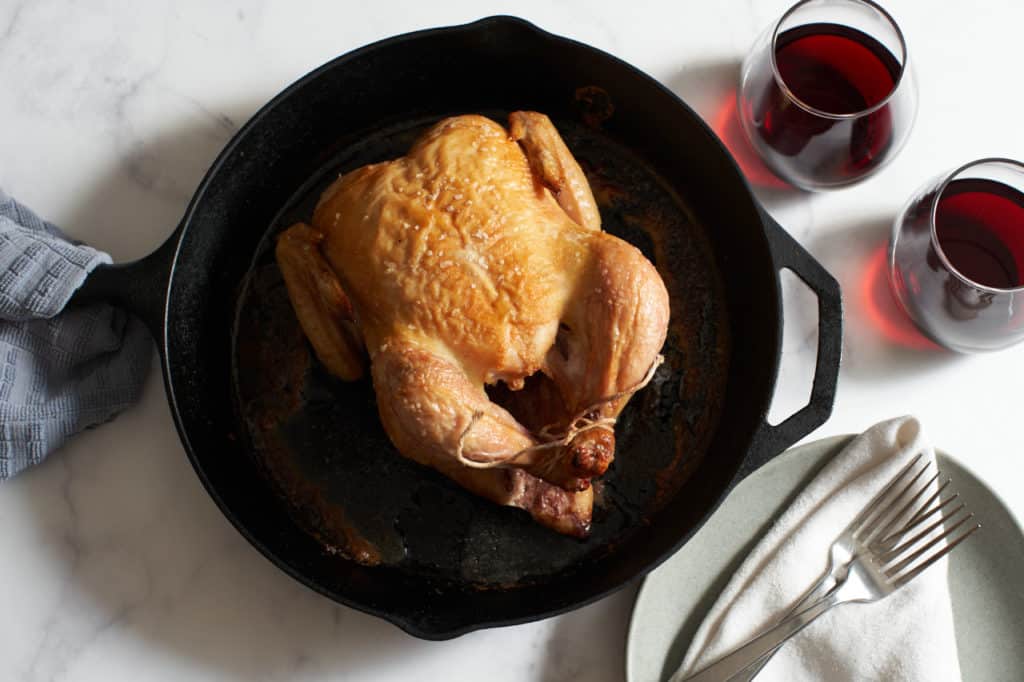
This post contains affiliate links. If you purchase through one of my links, I may make a small commission at no additional cost to you. As an Amazon Associate, I earn from qualifying purchases. Read my full disclosure policy here.
Have you always wanted to roast a whole chicken but are feeling daunted and overwhelmed with questions about how to cook it: What temperature should the oven be? How long do you cook it? How do you get crispy skin? Well, fear not! I am here to help.
I'm usually surprised when people say they are afraid to roast a chicken because they worry it's too hard to do or might come out overcooked. It's much easier than you think. (I'm much more afraid of cooking those boneless, skinless chicken breasts...but that's another story.)
I roast a chicken once a week for my husband and I, and we get three or more nights of meals out of it. It's economical and it makes meal planning for the week much easier. Using this simple recipe adapted from Thomas Keller, your chicken will come out perfectly every time.
Jump to:
Roast chicken is an easy, affordable recipe that you can make with 2 ingredients in 2 steps!
- Chicken and salt are the only two ingredients you need. (But you can add more herbs if you like.)
- Season the chicken, then roast it. It really is that simple.
- Whole chickens are less expensive per pound than buying specific cuts.
- A whole roast chicken will feed several people at a dinner party or a couple of people over a few meals.
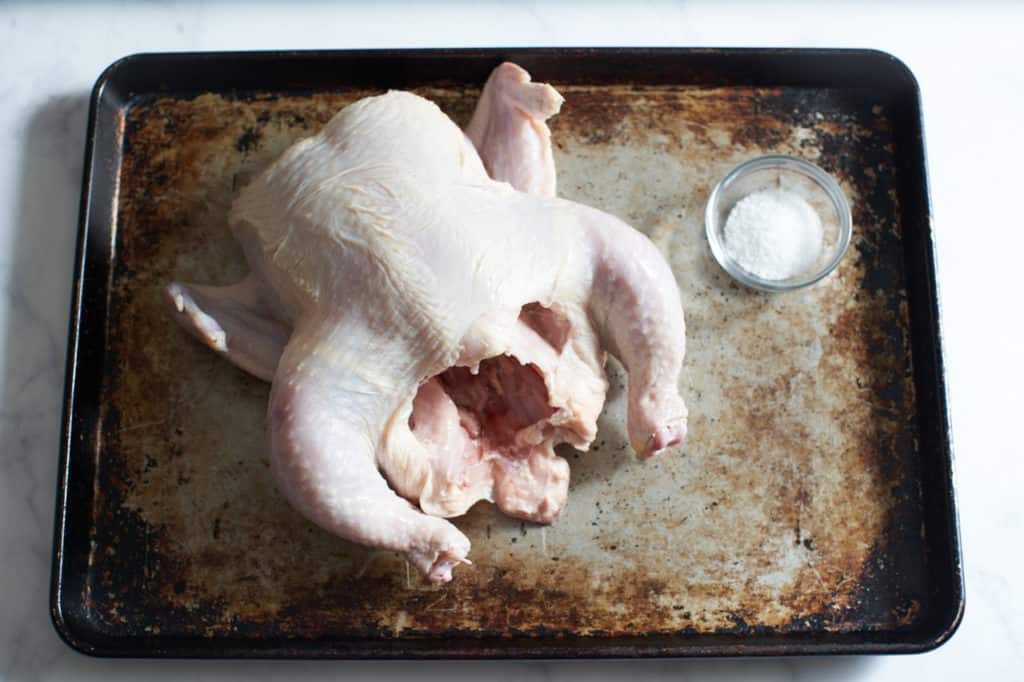
Ingredients you'll need
- Whole chicken: Usually labeled as a roaster or broiler. You can find everything from "all-natural" to pasture-raised to organic. Choose what is best for your budget. On average, the whole chickens that I buy weigh about 5 pounds.
- Kosher salt: You'll need about 1 tablespoon of salt for the whole chicken. I know that sounds hard to believe but it's true!
How to roast a chicken
Step 1: Pat the skin dry and season the chicken
Preheat the oven to 450 degrees F.
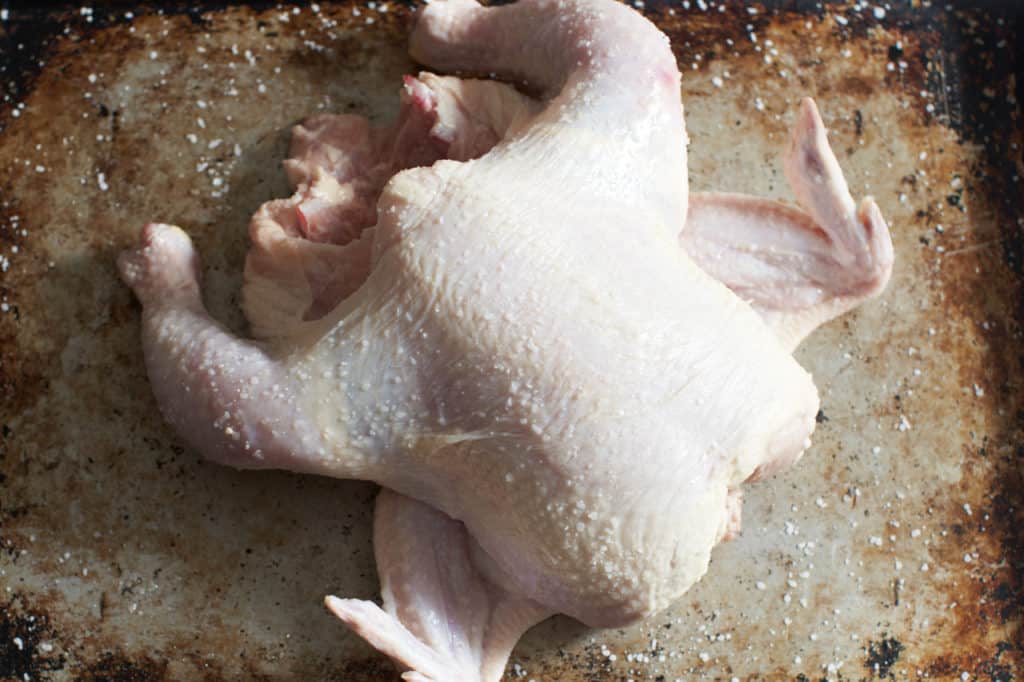
Remove the chicken from the packaging and place on a sheet pan. You may want to use kitchen shears to cut off any excessive fat near the cavity opening and around the neck area.
Want to save this recipe?
Pat dry with paper towels. Season inside the cavity with salt. Then season the outside of the chicken by sprinkling the salt from a height, hitting all areas of the skin. At this point, you could leave the salted chicken uncovered in the fridge overnight for even crispier skin.
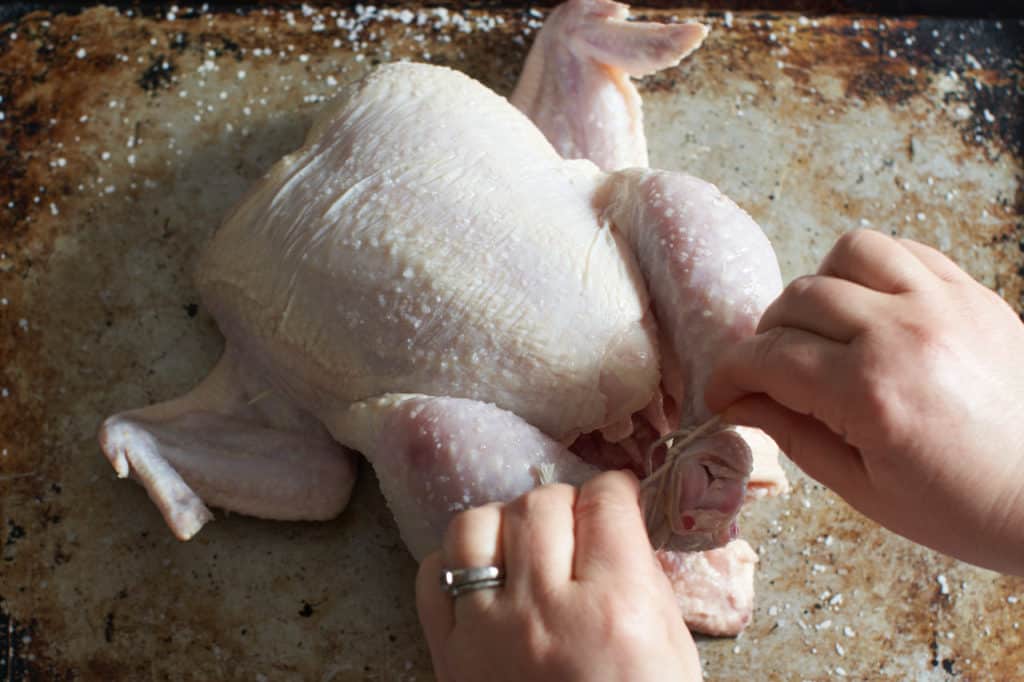
If you'd like, you can truss the bird or tie the legs together with kitchen twine, but it's not required. You don't need any fancy knots, just criss-cross the ankles and tie them together.
Step 2: Place the chicken in a pan and roast it!
Place the chicken in a cast iron pan, a roasting pan, or on a wire rack over a sheet pan and roast for about an hour. As always, be sure to wash your hands after handling raw meat.
Depending on the size of your chicken, start checking the temperature after 40-45 minutes with an instant read thermometer inserted into the thickest part of the breast.
When the breast temperature reaches 155-160 degrees F, remove it from the oven and let rest for at least 10-15 minutes before serving. This ensures that the carry over cooking will bring it to the proper temperature of 165, and the juices will redistribute evenly throughout the meat.
What to serve with roast chicken
Once you learn how to roast a chicken perfectly, it can be one of the most versatile recipes in your arsenal and a perfect entrée to serve year-round. It's regal and beautiful enough to be the centerpiece of a dinner party or an easy holiday meal, and humble enough to be a weeknight workhorse.
Try these sides as the seasons change.
- In the summer, try a Strawberry Arugula Salad with Basil and Mint or this Zucchini Salad with Herbs, Almonds, and Lemon-Caper Dressing.
- In fall and winter, how about Honey Roasted Brussels Sprouts, Spoonbread with Jalapeños, or Oven Roasted Carrots with Tahini Sauce and Cilantro.
- Any time of year, you can never go wrong with a side of Crispy Roasted Potatoes and a Massaged Kale Salad with Lemon-Basil Dressing.
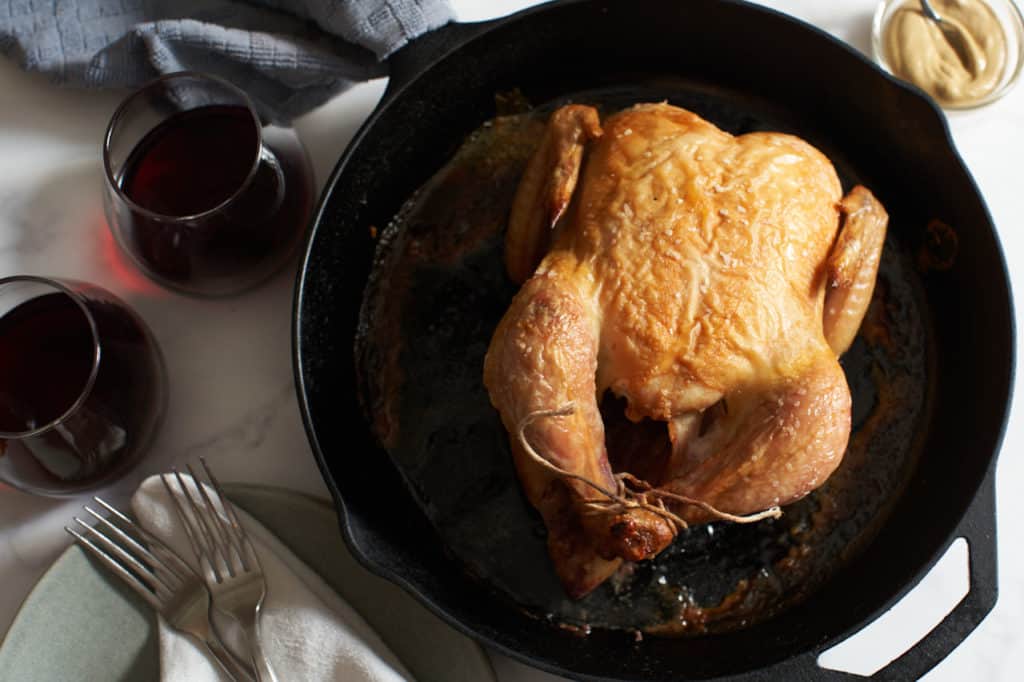
FAQ
No, you don't and you really shouldn't. The only thing you need to do is pat it dry. Washing it is more likely to spatter bacteria all around your sink and kitchen.
Pat the chicken dry before salting and cook it at a high temperature. For the crispiest skin, pat the chicken dry and salt it, then leave it uncovered in the fridge overnight.
A 12" cast iron skillet is always a good choice. Other options include a small roasting pan with or without a rack, on a wire mesh rack set atop a sheet pan, in an oven-proof skillet, or even a ceramic baking dish.
Trussing is not necessary for a good roast chicken. In some cases, trussing can help the bird cook more evenly, but if you watch the time and the temperature, the breasts shouldn't dry out. If you like the look of it better, you can simply tie the legs together as I did in the photos above. But I did this purely for pretty photos. Normally I just put it in the oven with no tying or trussing and it tastes great!
If you prefer crispy skin, go with high heat for a shorter period of time and roast at 450 degrees F for 45 minutes to an hour or so, depending on the size of the chicken. This method gives you tender meat and crispy skin. You can also go "low and slow" at about 300 degrees F to 350 degrees F for 1 ½ to 2 hours if you prefer the meat to be falling off the bone and a less crispy skin.
The amount of time required depends on the size of the bird and the temperature you choose. As stated above, if you roast at a higher temperature (above 400 degrees F), you can plan for anywhere from 45 minutes to 90 minutes. If you choose a lower temperature, it could take up to 2 hours. That's why an instant read thermometer is your best tool. You'll know it's done when it reaches the correct temperature.
For safe consumption, chicken must reach an internal temperature of 165 degrees F. Many people will tell you to test the thigh temperature, but I don't trust this method. Because chicken breasts these days tend to be so much larger compared to the thighs, I insert an instant-read thermometer into the thickest part of the breast, avoiding the bone, and remove the chicken from the oven when it is 155-160 degrees F. Let the chicken rest for 10-15 minutes when it comes out of the oven and the carry-over cooking will finish the breast perfectly to a temperature of 165 degrees F.
Tips for perfectly cooked roast chicken
- Once a chicken starts getting close to being done, the internal temperature will increase rapidly, so check frequently to avoid overcooking. The more often you make roast chicken, the sooner you'll start to get a feel for how long to cook it, when to check the temperature for the first time and how long to wait to check it again.
- For the crispiest skin, season the chicken then leave uncovered in the refrigerator overnight. This allows the skin to dry out a bit and get ultra-crispy!
- Don't be heavy handed with the salt. You might think that because you're roasting a whole bird that you need a lot, but it 1 tablespoon will really do the job.
- If you like, you can add a cut lemon and/or sprigs of thyme or rosemary to the chicken cavity for added flavor and aroma.
More roast chicken recipes
- Now that you know the basics of roasting a whole chicken, why not try this Roast Chicken with Tarragon and Lemon? It's spatchcocked - which means the backbone is removed - and cooks a little faster.
Recipe
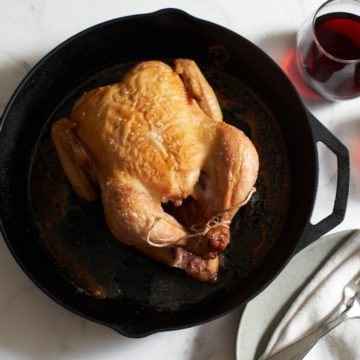
Roast Chicken
Want to save this recipe?
Instructions
- Preheat the oven to 450 degrees F.
- Remove the chicken from the packaging and place on a sheet pan. You may want to use kitchen shears to cut off any excessive fat near the cavity opening and around the neck area.
- Pat dry with paper towels. Season inside the cavity with salt. Then season the outside of the chicken by sprinkling the salt from a height, hitting all areas of the skin. If you'd like, you can truss the bird or tie the legs together with kitchen twine, but it's not required. You don't need any fancy knots, just criss-cross the ankles and tie them together.
- Place the chicken in a cast iron pan, a roasting pan, or on a wire rack over a sheet pan and roast for about an hour. As always, be sure to wash your hands after handling raw meat.
- Depending on the size of your chicken, start checking the temperature after 40-45 minutes with an instant read thermometer inserted into the thickest part of the breast. When the breast temperature reaches 155-160 degrees F, remove it from the oven and let rest for at least 10-15 minutes before serving. This ensures that the carry over cooking will bring it to the proper temperature of 165, and the juices will redistribute evenly throughout the meat.
Notes
- For safe consumption, chicken must reach an internal temperature of 165 degrees F.
- Once seasoned, you could leave the chicken uncovered in the fridge overnight for even crispier skin.
- Once a chicken starts getting close to being done, the internal temperature will increase rapidly, so check frequently to avoid overcooking. The more often you make roast chicken, the sooner you'll start to get a feel for how long to cook it, when to check the temperature for the first time and how long to wait to check it again

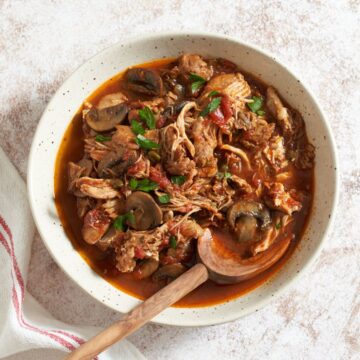
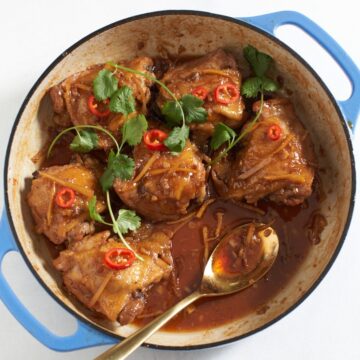
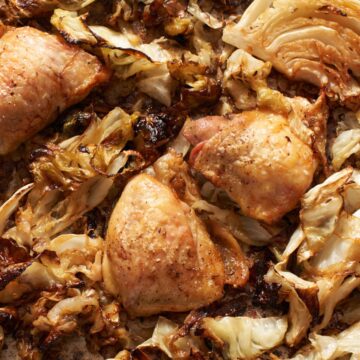
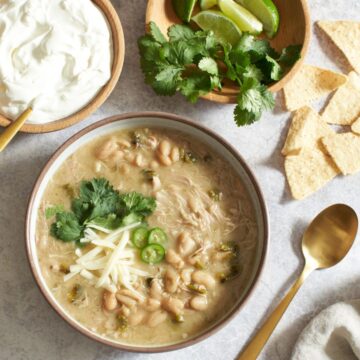
Leave a Reply